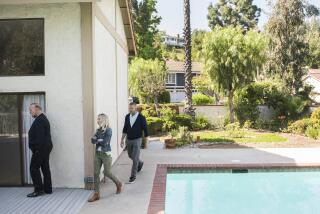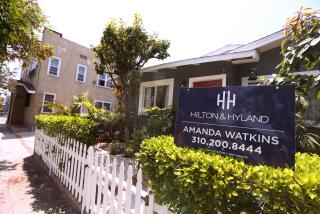State’s rate of default soars to 9.5%
About 1 in 10 Californians with a home loan is now in default, and there’s growing evidence that the mortgage meltdown is spreading to commercial real estate.
The home mortgage delinquency rate -- the percentage of borrowers who have missed several payments and are in the first stage of foreclosure -- climbed in June to 9.5% in California and 9.9% in Los Angeles County, according to First American CoreLogic.
The staggering number of home mortgage defaults probably will lead to large numbers of foreclosures through at least this year, housing experts say.
“It’s probably a given we’ll see a high number of foreclosures in the next couple of quarters due to the level of defaults plus the recession and jobs lost. There’s plenty more pain to come,” said Andrew LePage, an analyst for real estate research firm MDA DataQuick of San Diego.
Mortgage defaults are more likely to result in foreclosure when borrowers owe more on their homes than they are currently worth -- commonly called being “upside down” or “underwater” in industry lingo.
That’s the case for many in California who bought homes during the real estate bubble, often with little or even no money down.
When distressed borrowers have equity, they often can sell the property to cover the outstanding mortgage. For upside-down borrowers, that’s usually not an option.
In recent months, about 60% of California mortgages in default ended up foreclosed, LePage said.
Foreclosures should pick up even more now that various government moratoriums and voluntary foreclosure freezes by lenders have expired.
But LePage said the rate of foreclosures may not reach the record level set last year if lenders increase loan modifications or approve more “short sales,” in which homes are sold for less than their mortgage amounts.
The mortgage delinquency rate in June was up sharply from a year ago, when 6% of California mortgages were delinquent and 5.2% in Los Angeles County were in default.
In May 2009, the state default rate was 9.2% and the Los Angeles County rate was 9.5%, according to First American CoreLogic.
At the same time, the California Mortgage Bankers Assn. reported a surge in the number of commercial real estate loans in default. The total number of delinquent commercial loans remains small -- only 14 of 6,497 loans in the statewide survey -- but industry analysts say more defaults are on the way.
Low interest rates are enabling many commercial borrowers to stay current on loans, but that’s certain to change if rates rise, and a high percentage of office, retail and apartment buildings are already underwater.
“There’s no question we’re going to see more commercial properties end up in restructuring; the question is how much,” said Dan Fasulo, managing director of Real Capital Analytics, a New York research firm.
Fasulo said lenders are trying to avoid foreclosures on commercial properties partly because they don’t want to take on properties they would have trouble selling.
“They’re saying, ‘If we foreclose now, what are we going to do with it?’ This is the worst market to sell property in modern times.”
Lenders have been making allowances to upside-down borrowers, hoping to keep from foreclosing long enough for commercial real estate values to recover, Fasulo said. There’s now a popular street term for the practice, he said: “extend and pretend.”
--
More to Read
Inside the business of entertainment
The Wide Shot brings you news, analysis and insights on everything from streaming wars to production — and what it all means for the future.
You may occasionally receive promotional content from the Los Angeles Times.










